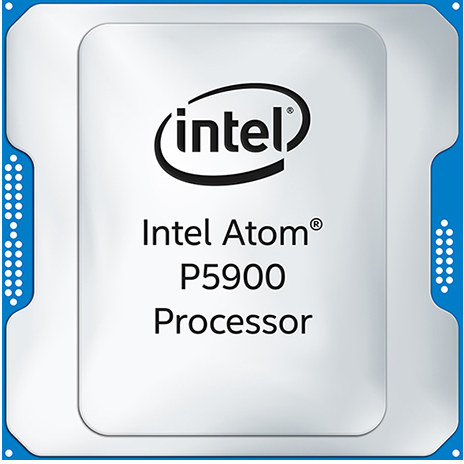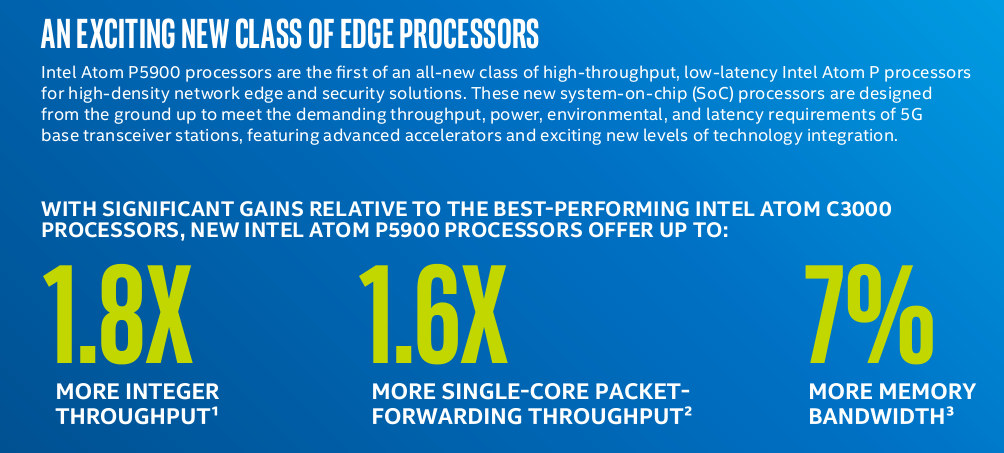Intel may have given up on developing 5G modems for mobile devices, but the company will still be participating in the ramping up of 5G technology by focusing on 5G infrastructure instead.
So the company has just introduced the Atom P5900 “Snow Rigde” processor family designed for 5G wireless base stations requiring “high throughput, low latency processing for high-density network edge and security solutions”. The 10nm chips are offered with 8 to 24 cores based on the Tremont micro-architecture.
There are four Atom P5900 “Snow Ridge” processors so far:
- Intel Atom P5921B 8-core processor @ 2.20 GHz with 9MB cache
- Intel Atom P5931B 12-core processor @ 2.20 GHz with 13.5MB cache
- Intel Atom P5942B 16-core processor @ 2.20 GHz with 18MB cache
- Intel Atom P5962B 24-core processor @ 2.20 GHz with 27MB cache
P5912B supports up to 64GB ECC DDR4 memory, and other parts can handle up to 128GB RAM. The rest of the features are identical for all four SKUs:
- SATA – 16x SATA interfaces
- Networking – Integrated Intel Ethernet 800 Series technology delivering up to 100 Gbps throughput; up to 440 Gbps network switching connectivity; Intel QAT support for 5.6x faster secured network communication compared to software
- PCI – Support 16x PCIe 3.0, 16x PCIe 2.0 in x4,x8 and x16 configurations. 32 PCIe lanes max.
- USB – 4x USB 2.0, 4x USB 3.0
- Security & Reliability – Intel AES New Instructions, Secure Key, Intel Trusted Execution Technology, Execute Disable Bit, Intel Boot Guard
- Package Size – 47.5mm x 47.5mm
- Temperature Range – -40°C to 85°C
Compared to the previous Intel Atom C3000 Denverton server SoC, Atom P5900 Snow Ridge processor delivers 1.8 times more integer throughput (in SPECrate*2017_int_base), 1.6 times more single-core packet forwarding throughput (tested with DPDK L3FWD-ACL) and 7% more memory bandwidth as measured with STREAM_triad benchmark.
The company expects the new Atom P processors to help them become the leading silicon provider in base stations by 2021. Visit the product page and/or check the product brief for more information.

Jean-Luc started CNX Software in 2010 as a part-time endeavor, before quitting his job as a software engineering manager, and starting to write daily news, and reviews full time later in 2011.
Support CNX Software! Donate via cryptocurrencies, become a Patron on Patreon, or purchase goods on Amazon or Aliexpress







8-24 cores, 16x SATA interfaces …. we can really build a nice NAS with it! 🙂
Sure it can 🙂 IF someone would need 100Gbps Ethernet interface and is willing to pay for that.
> is willing to pay for that.
This!
I expect that these will be found in many other network devices than just 5G base stations. Routers, firewalls, load balancers, UTM devices etc all seem to make sense for these. And of course, NAS as Gaetano said.
I don’t see how that feature set would be useful for making a cellular base station *at all*. That’s a warmed over NAS chip and nothing more. It’s the wrong mix of I/O for a base station.
How to make the last cycle’s products relavent this cycle : sed s/iot gateway/5g something/
There’s likely a bit of this. When you see a marketing doc mention “7%” more memory bandwidth, you can easily imagine the marketing team saying “can we write 70%?” and the engineers say “no, really no, it’s 5%!”, then the other ones say “OK, let’s write 7 then” 🙂 I don’t know if anyone noticed that even the model number (59xx) is made to visually look like “5g”. With this said, I do appreciate seeing more cores and more network bandwidth in these network-oriented atoms. I don’t see QAT mentioned there, which is a bit surprising as it’s present in… Read more »
Sorry about not covering the QAT part, I’ll add it to the article together with a link to the product brief since it’s not that easy to find from the product page.
However the truth is that this device is exactly what a base station needs:
400Gbps Ethernet switching BW, up to 24 core computing performance, cypher accelerator.
The idea is to use x86 to replace ARM.
I’m guessing you have never been involved in the design of a cellular base station.
yes bloody assume for video storage but no one makes a board